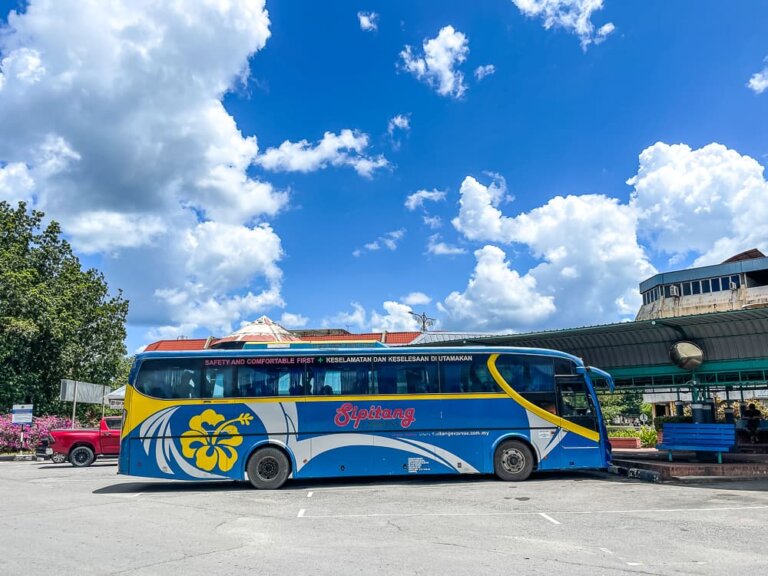This post may contain affiliate links, which means I’ll receive a commission if you purchase through my links, at no extra cost to you. Please read full disclosure for more information.
If you are into learning about the rich local Borneo culture, spending an afternoon at Mari Mari Culture Village is one of the best things to do in Kota Kinabalu.
Don’t get me wrong, the experience is one hundred percent designed for tourists. But that’s not always a bad thing. It means they have put a lot of thought into creating an experience that highlights various aspects of their culture, past and present. And I think in cases like this, being able to make a living sharing their heritage with visitors actually helps them honor and preserve their own history and traditions (while paying the bills!).
So, let me tell you everything you need to know to plan your visit to Mari Mari Culture Village!
The Mari Mari Culture Village Experience
Come, come, follow me!
According to our guide, that is actually the meaning of “mari mari”.
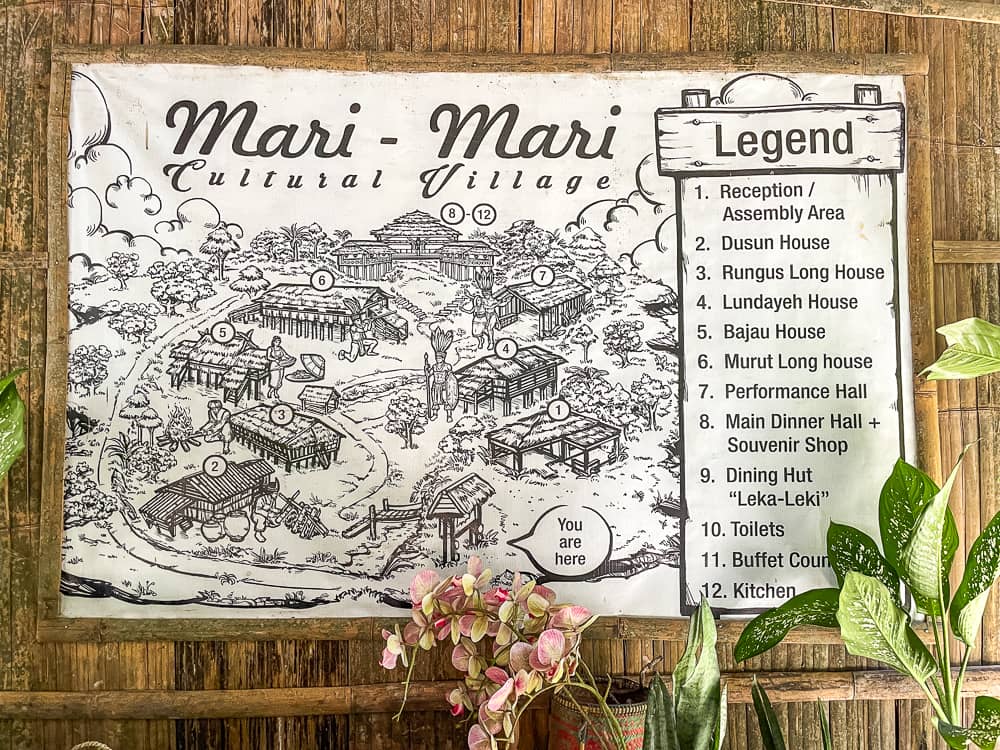
The Mari Mari Culture Village is essentially a living museum that showcases Borneo’s history and culture. Their motto or tagline is “As It Was… As It Is…” and they aim to preserve their culture by connecting the past to the present through displays and demonstrations.
Registration
The Mari Mari Culture Village is a pretty smooth operation.
As soon as you arrive, register with the front desk and they will tell you which group you are in. As of September 2024, they will issue you a wristband to wear for the duration of your tour.
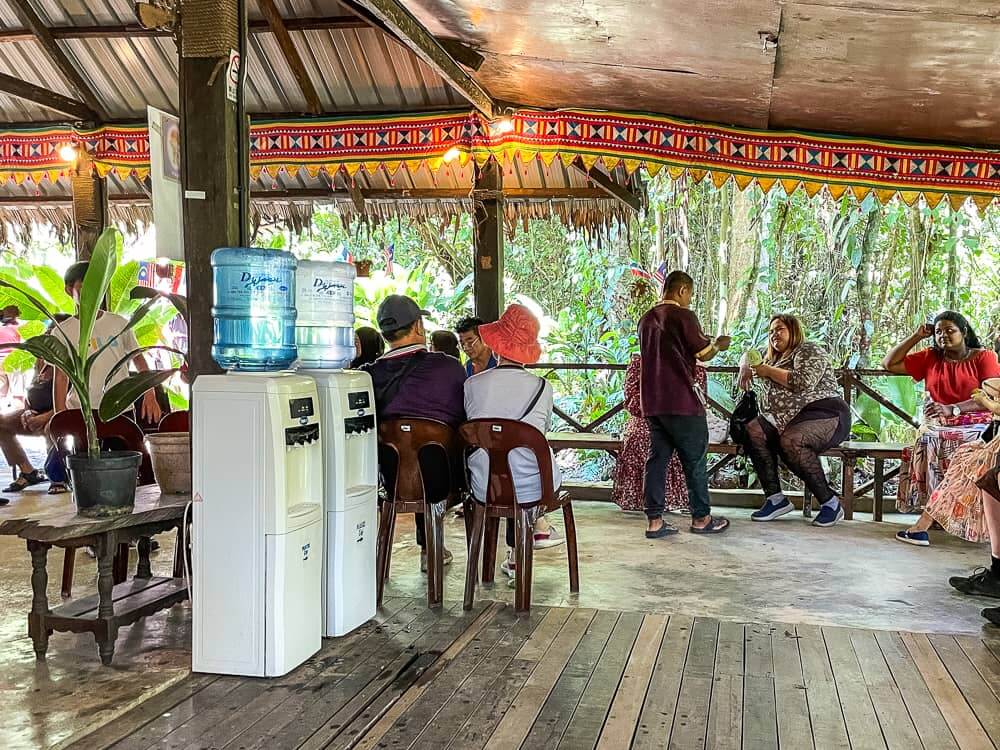
You then wait until your group is called and you are issued a friendly and informative guide. Then off you go into the village!
Visiting the Five Houses
The guide will take you through the five different houses at Mari Mari Culture Village, one for each ethnic group.
While the state of Sabah has 32 tribes and 72 sub-tribes, the Mari Mari Culture Village showcases the five major ethnic groups, in order of size:
- Kadazandusun (Dusun)
- Bajau
- Murut
- Rungus
- Lundayeh
You will visit the houses in random order, as they have to negotiate the logistics of guiding five different groups through all five houses simultaneously, without bumping into one another. It wouldn’t make sense for everyone to go into the houses in the same order.
Here is a brief overview of what to expect at each of the five houses, based on my experience:
Kadazandusun (Dusun) House
Information on the house entrance sign: Dusun tribe has several sub-tribes who use the same language between them, the largest tribe in Sabah.
Aramaiti! That means “let’s party” in the Dusun house.
The Dusun people are primarily farmers and traders. And the first thing you’ll learn is how to make rice wine. And you’ll get to taste it too! It’s light and refreshing on a hot Borneo day.
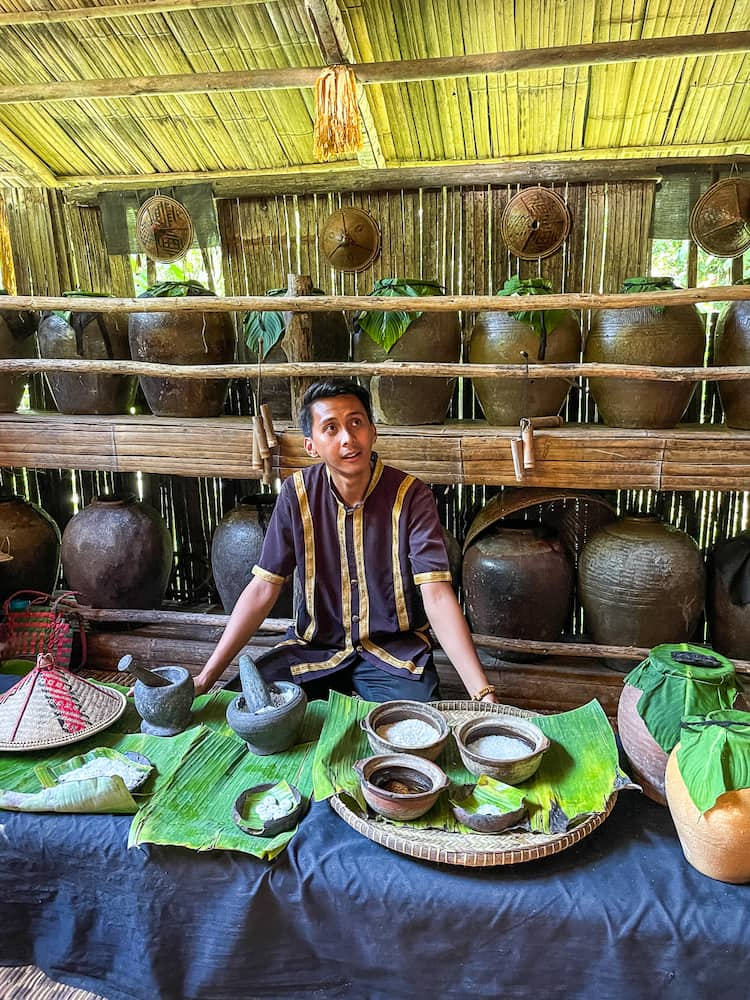
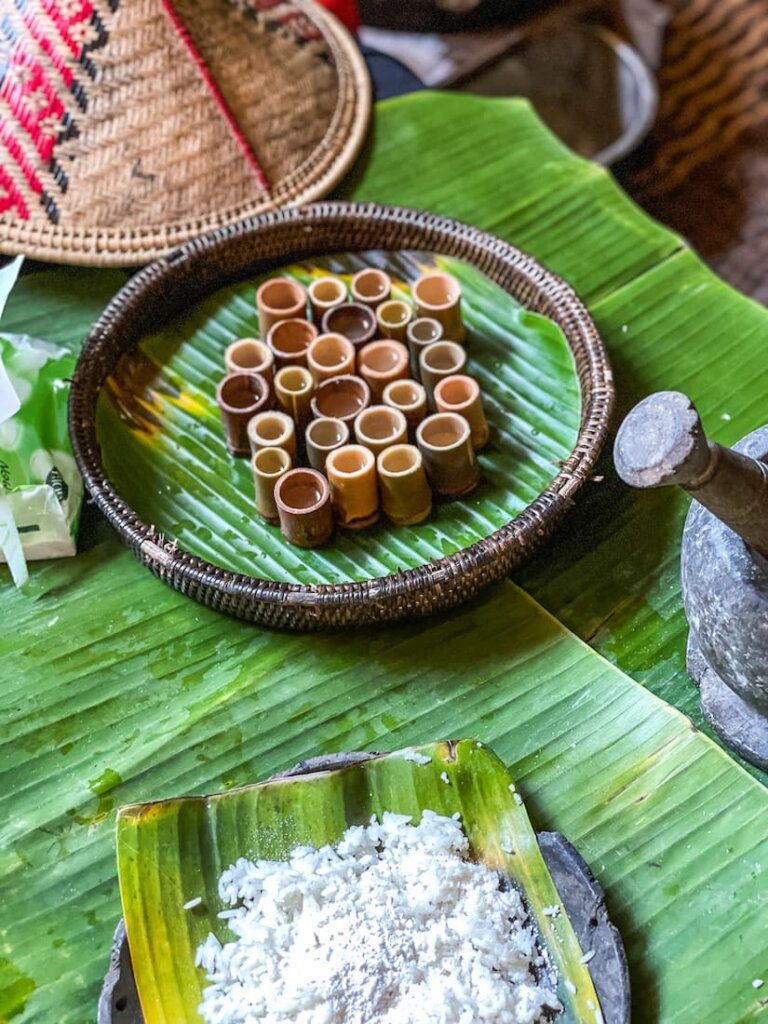
By now you might be starting to work up an appetite.
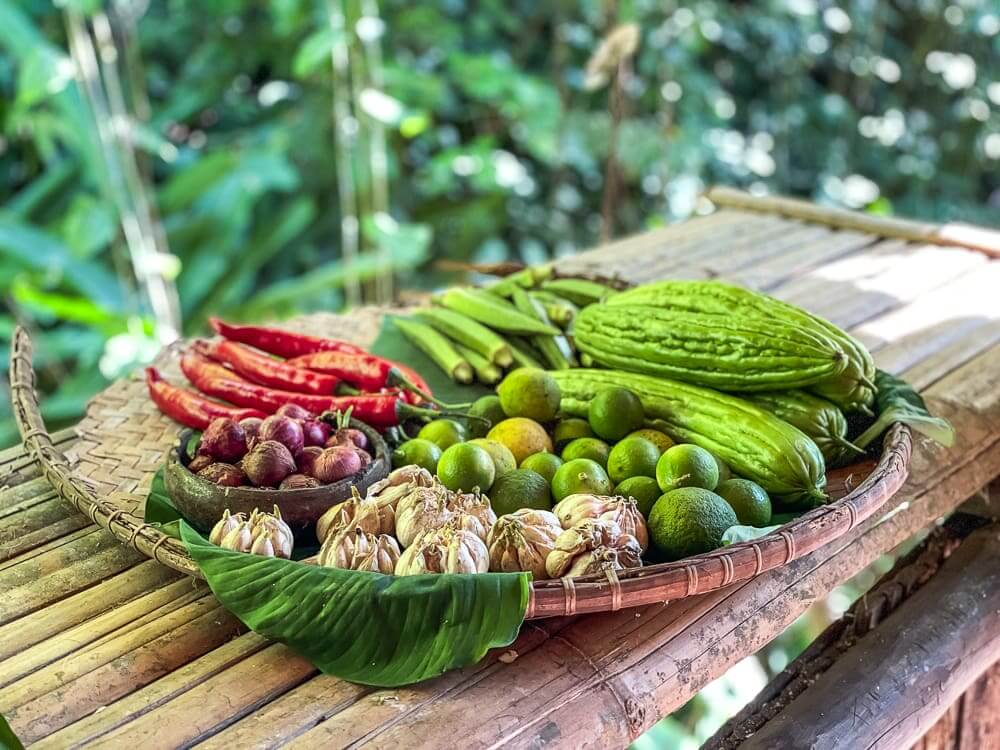
Lucky for you, they are cooking up some bamboo chicken at the Dusun house, and you will get to try the local cuisine.
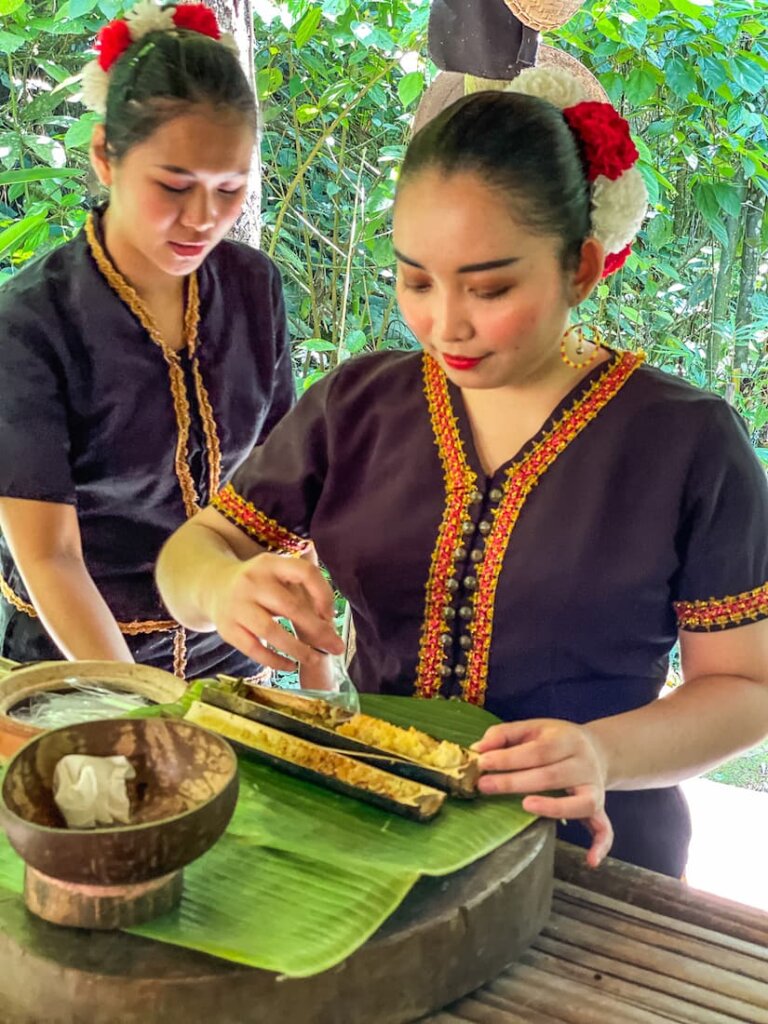
Summary: At the Dusun house you will learn how to make rice wine. Even better, you will get to taste rice wine and eat bamboo chicken.
Bajau House
Information on the house entrance sign: The Bajau is the second largest ethnic group in Sabah after Kadazandusun…this people originally from the Philippines-Sulawesi, landed on Sabah’s shores 500 years ago.
You might have heard the Bajau people as the Sea Gypsies, known for their freediving skills—but there are other, more land-lubbing, Bajau known for their horse riding skills.
There isn’t really a sign of either of those skills at the Bajau house, but you will find a beautiful colorful interior, fit for a lavish wedding.
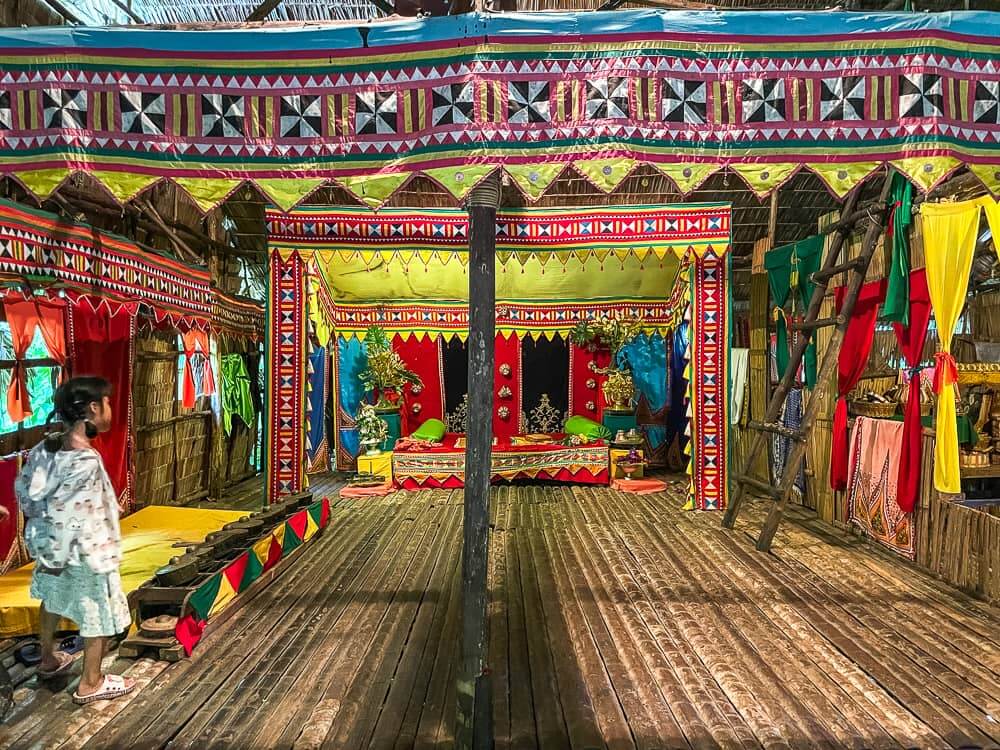
You will also find some lovely ladies demonstrating how to fry up some delicious crunchy kuih jala (coconut rice snacks).
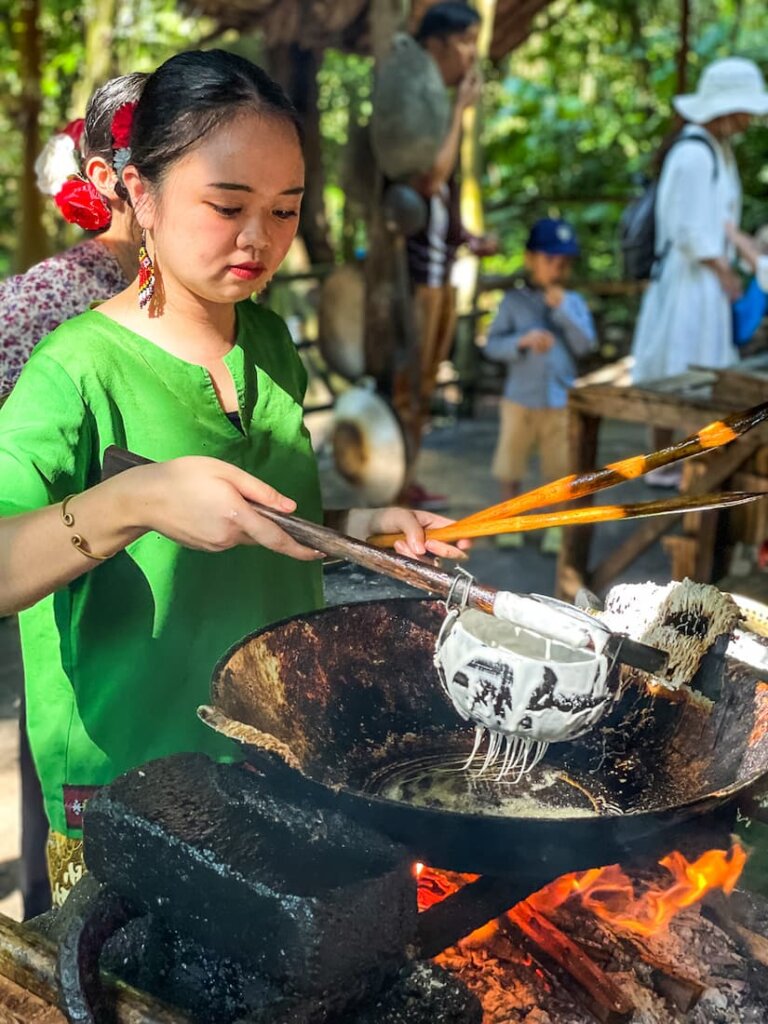
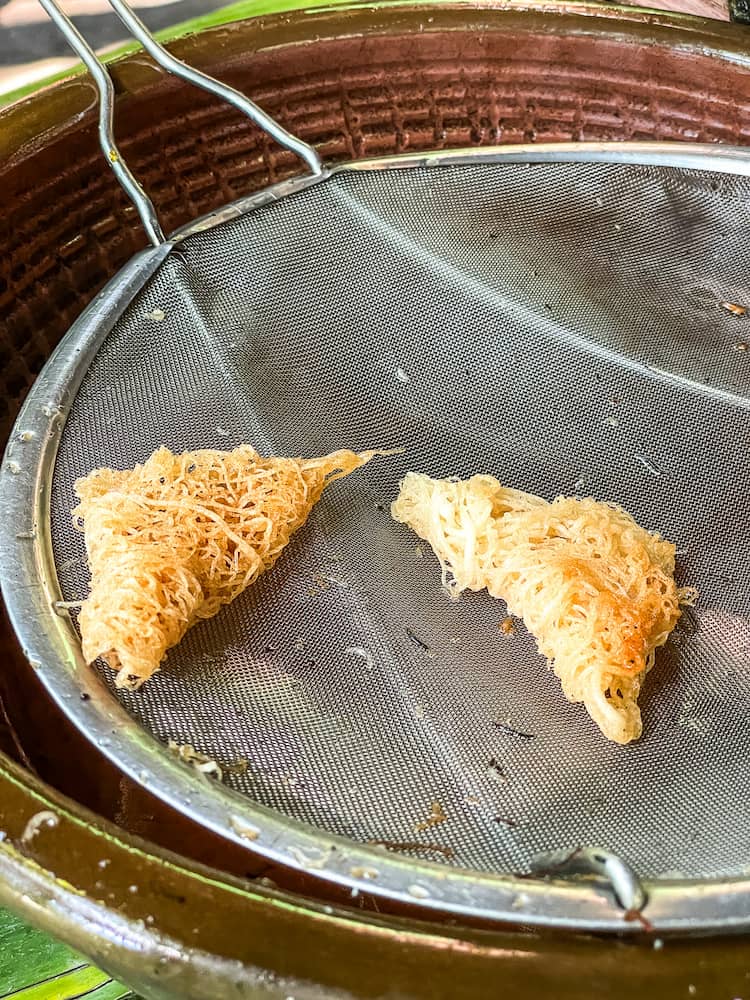
Summary: At the Bajau house you will try pandan juice and see how they make kuih jala—and of course taste it all.
Murut House
Information on the house entrance sign: The Murut is the third largest ethnic group in Sabah and are concentrated in the interior district of Tenom and surrounding areas. They are also known as “headhunters”.
The Murut are known as the most feared and ruthless headhunters. They would kill anyone of any age—man, woman, or child—without a second thought.
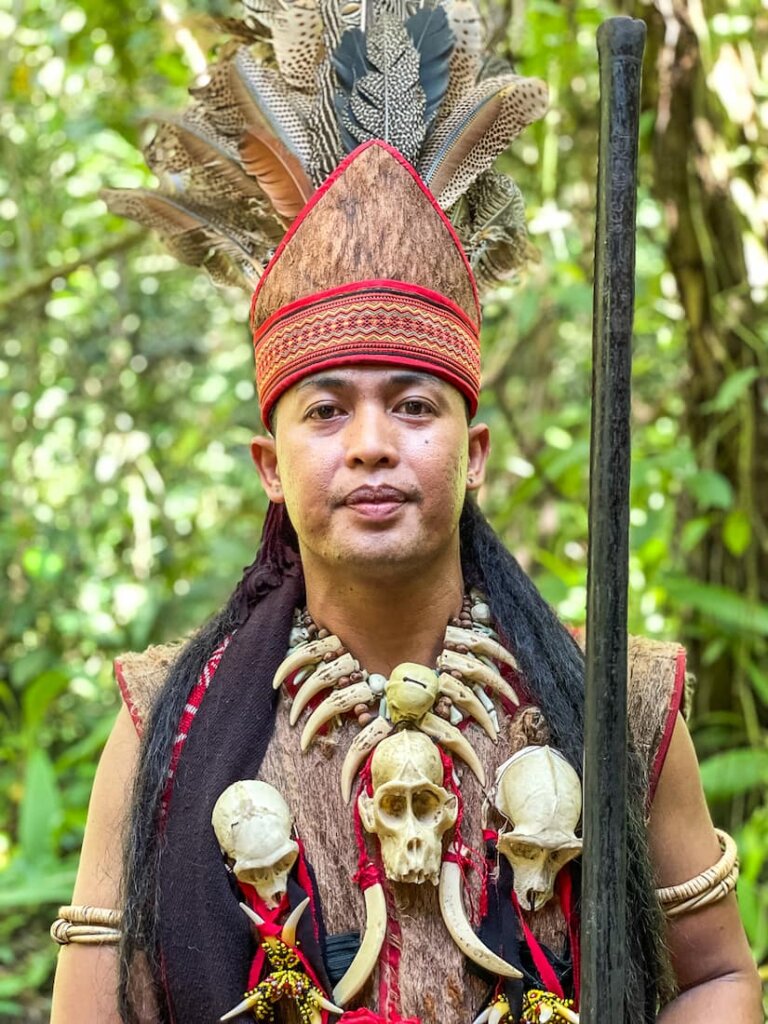
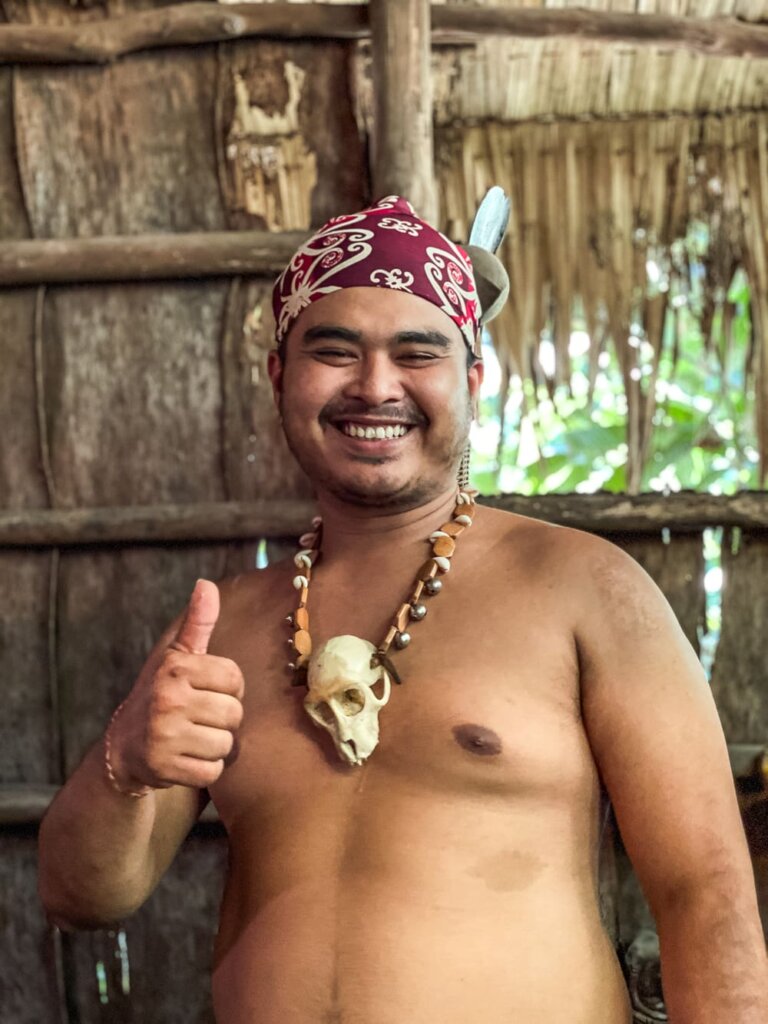
Lucky for you, the British put an end to the headhunting in 1950 (or so they say…), so the craziest thing you’ll witness at the Murut house is lansaran (trampoline) jumping. In the center of the Murut house, they build a lansaran out of ironwood, rattan, and wild guava tree.
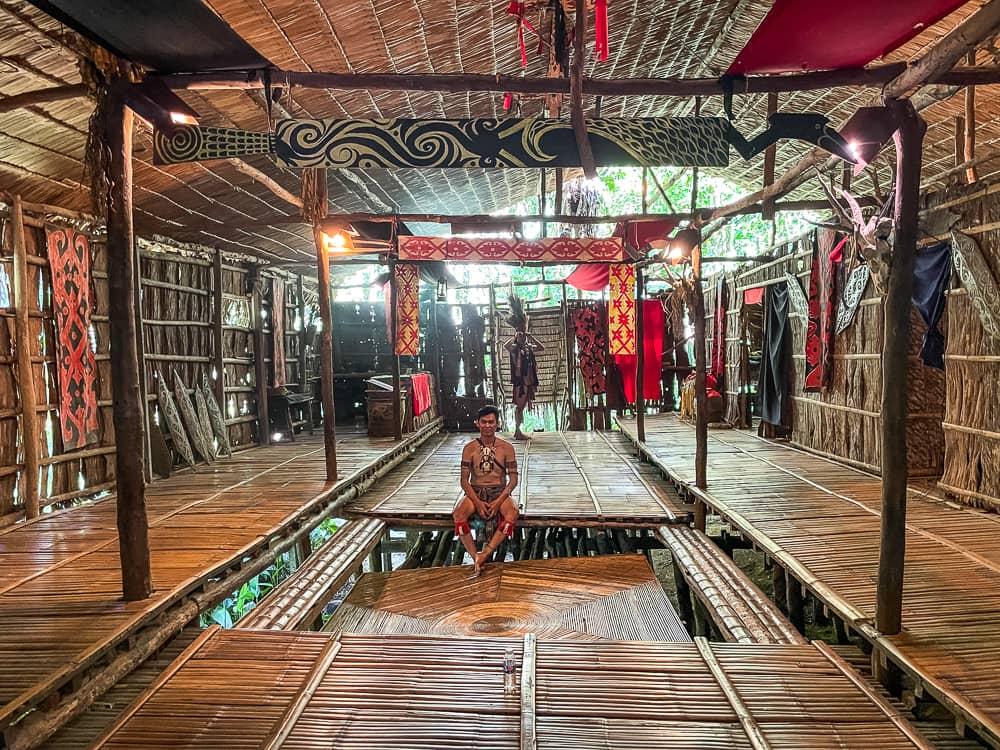
During celebrations, men jump together on the trampoline, and see who can leap high enough at just the right time to get his hands on the dangling prize above.
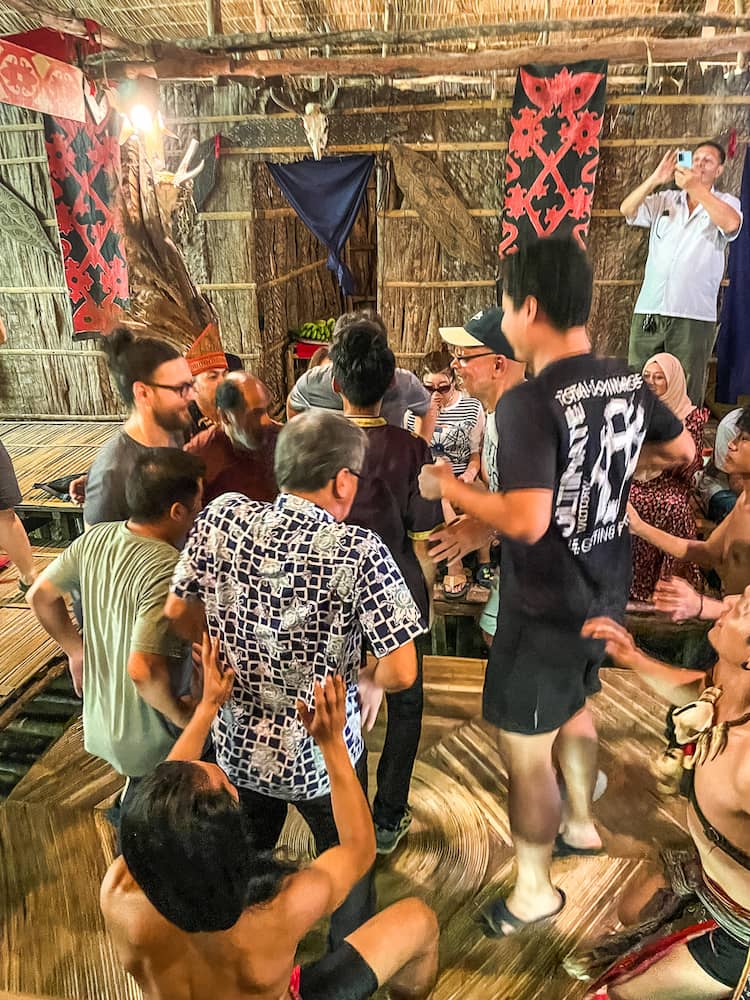
They make it look easy. Then they let you try it…and you can experience first-hand just how not-easy it is to be a Murut warrior.
Summary: At the Murut house you will meet some fearless headhunters, and try out the lansaran trampoline, if you dare.
Rungus House
Information on the house entrance sign: Rungus is the fourth biggest tribe in Sabah after Murut, Bajau, and Kadazandusun. The word Rungus comes from Tomborungus. He was the son of Aki Ragang who lived at the top of Mount Kinabalu.
The Rungus tribe are farmers and traders.
The village, with up to 25 families, lives together in one long house to better protect themselves from headhunters. The women and children sleep in smaller rooms, while the men sleep in the common area.
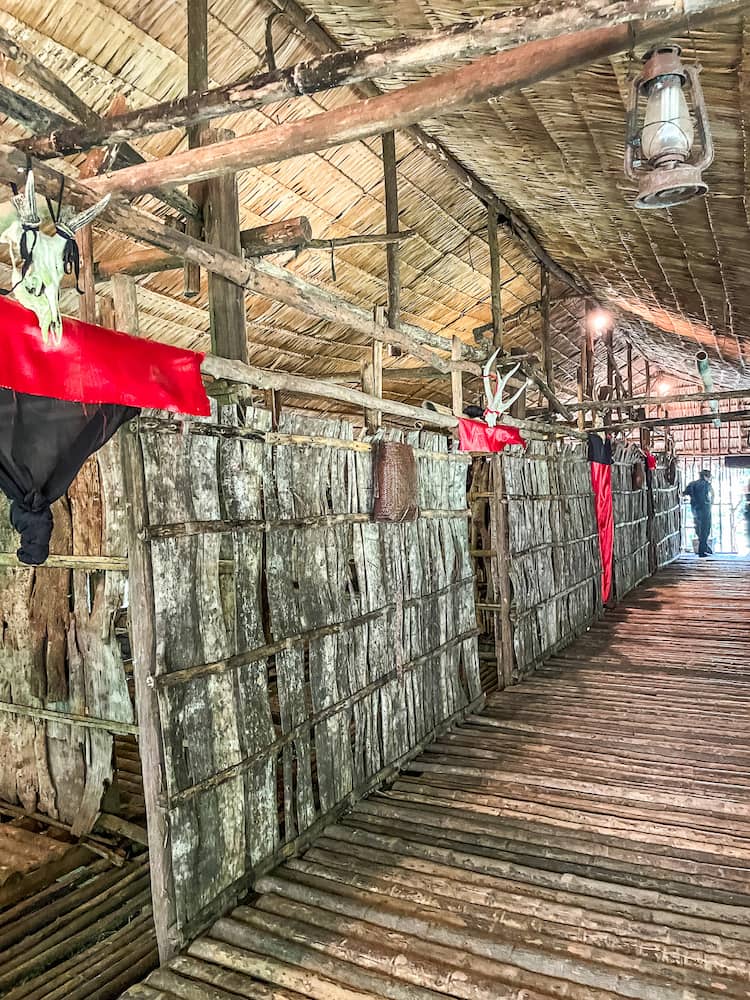
The men need to prove themselves as hunters before they are eligible to marry. The women need to learn to make fire. You too will learn to make fire!
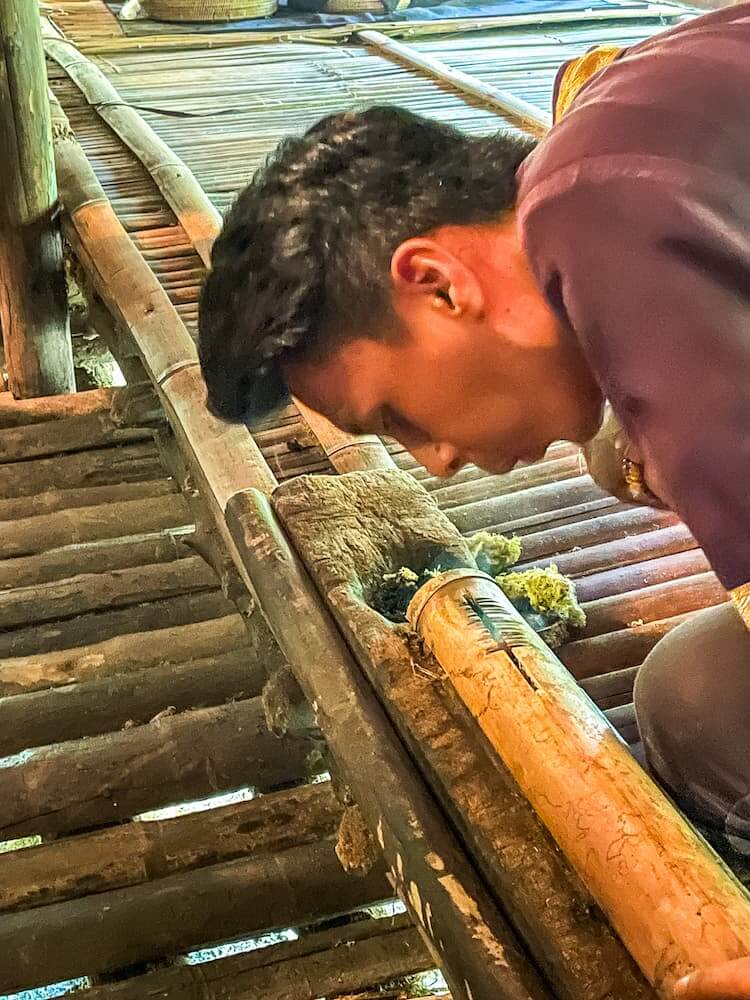
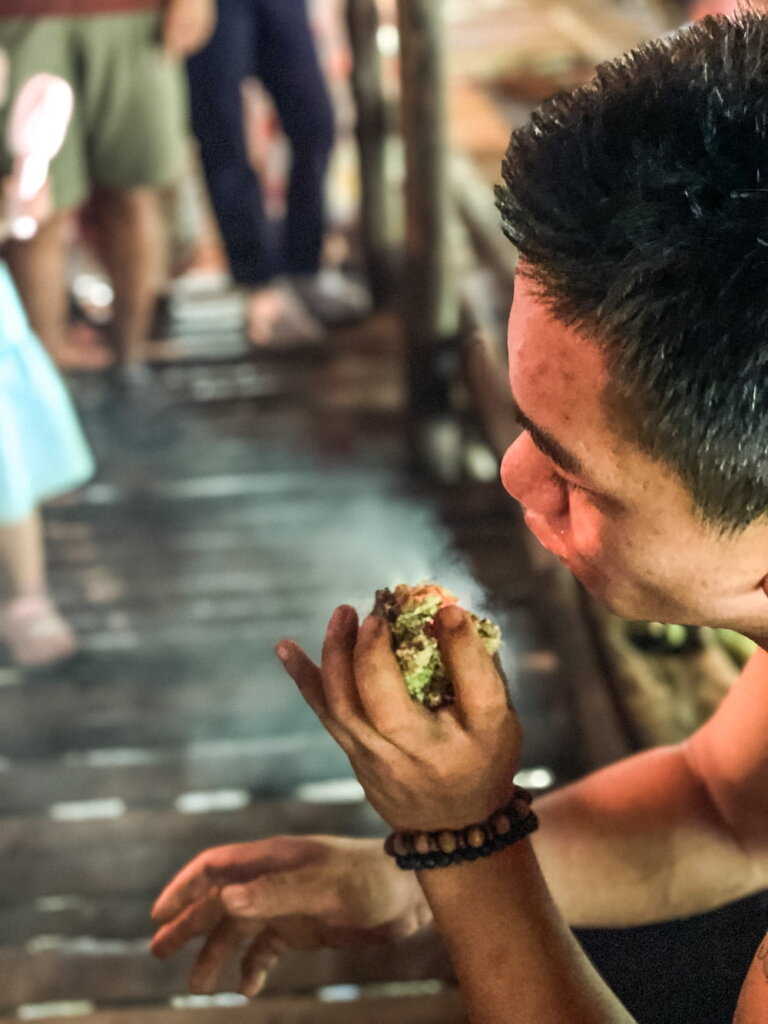
The Rungus are also beekeepers, and you get to taste their precious nectar.
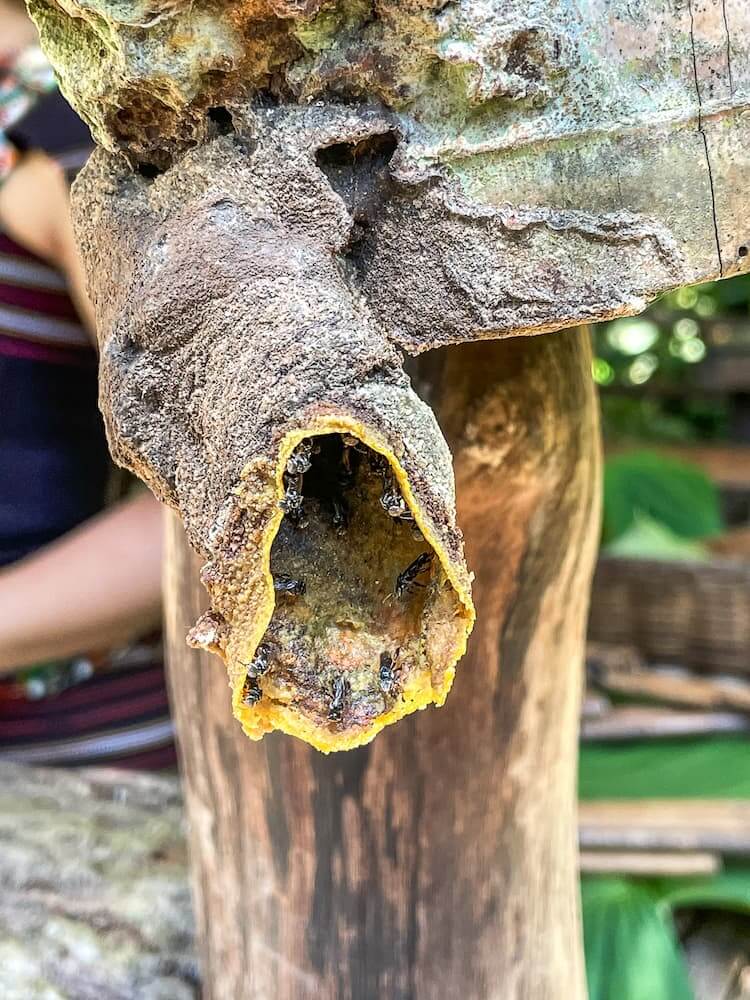
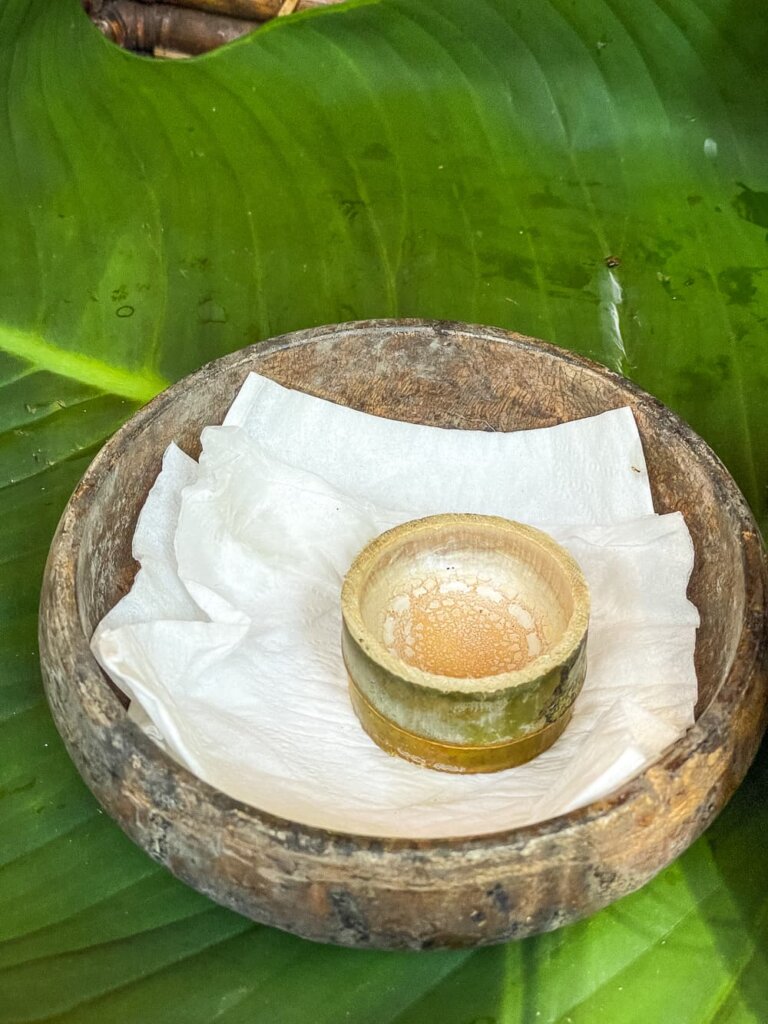
Summary: At the Rungus house you will see how they make honey from stingless bees (you get to taste it) and how they start a fire the traditional way.
Lundayeh House
Information on the house entrance sign: The Lundayeh tribe (also known as Lun Bawang)…is situated in the far southwestern corner where the state of Sabah meets Sarawak and Borneo Kalimantan lays the area of Ulu Padas.
The Lundayeh tribe are the fifth largest ethnic group in Sabah. They are farmers, hunters and fishermen…and headhunters (until the British put an end to that in 1950).
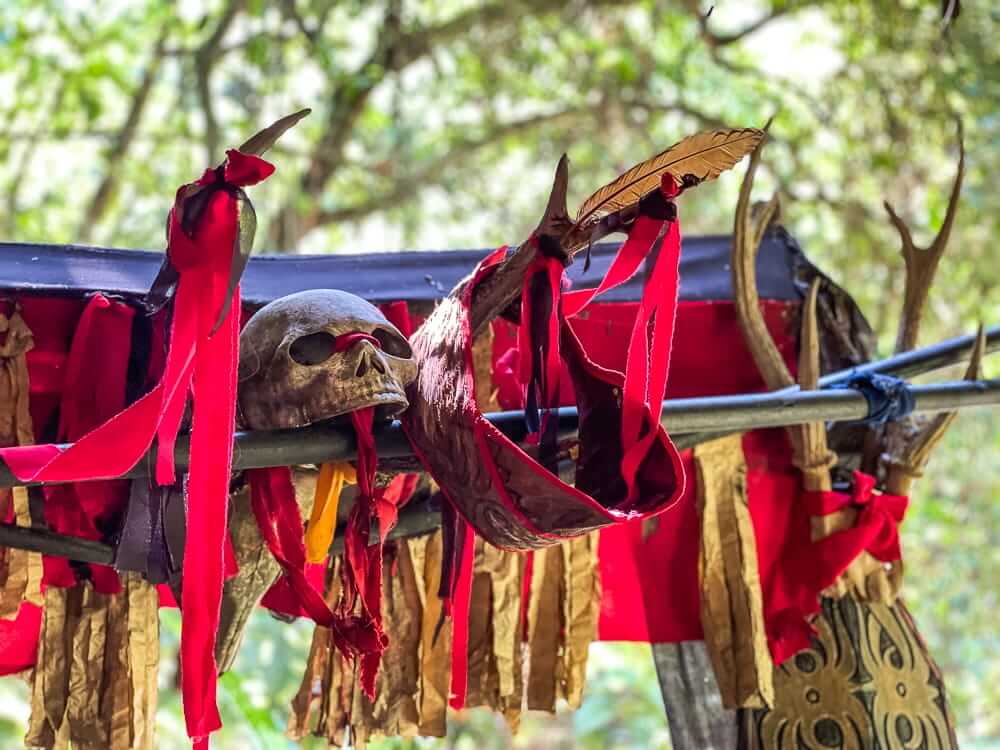
I should note that they made a point of saying that all skulls and bones displayed at Mari Mari Culture Village are fake.
These are some fierce and crafty folks.
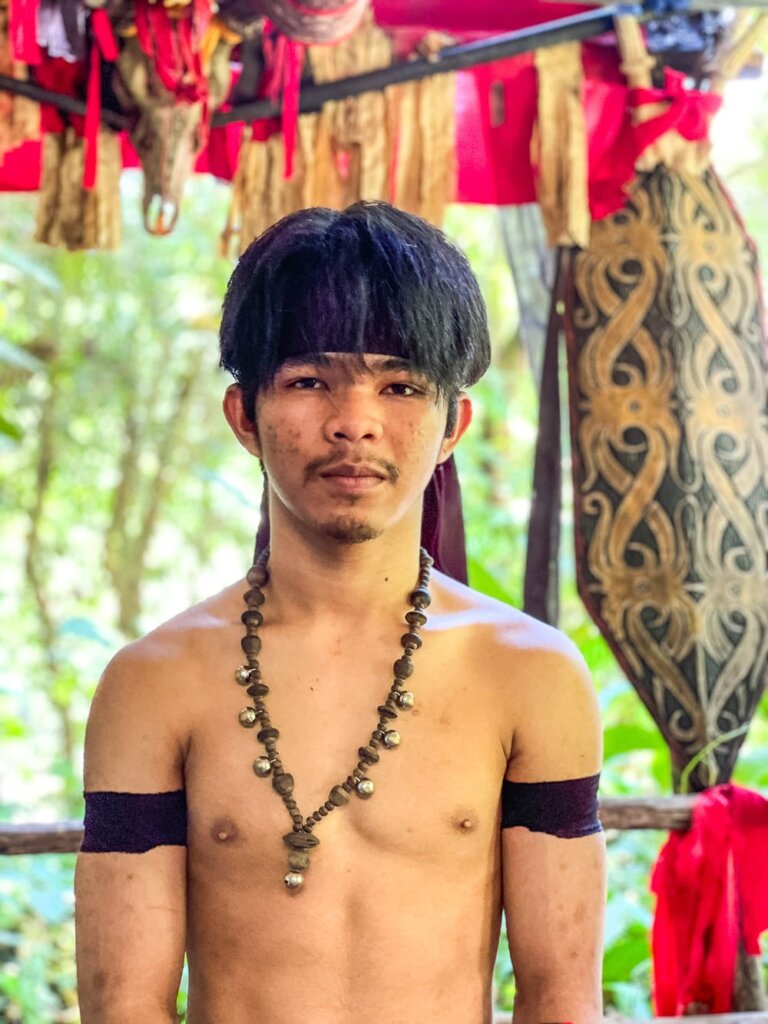
They specialize in making clothes from tree bark and using blowpipes to shoot poison arrows at their enemies (which is, basically, anyone not in their tribe).
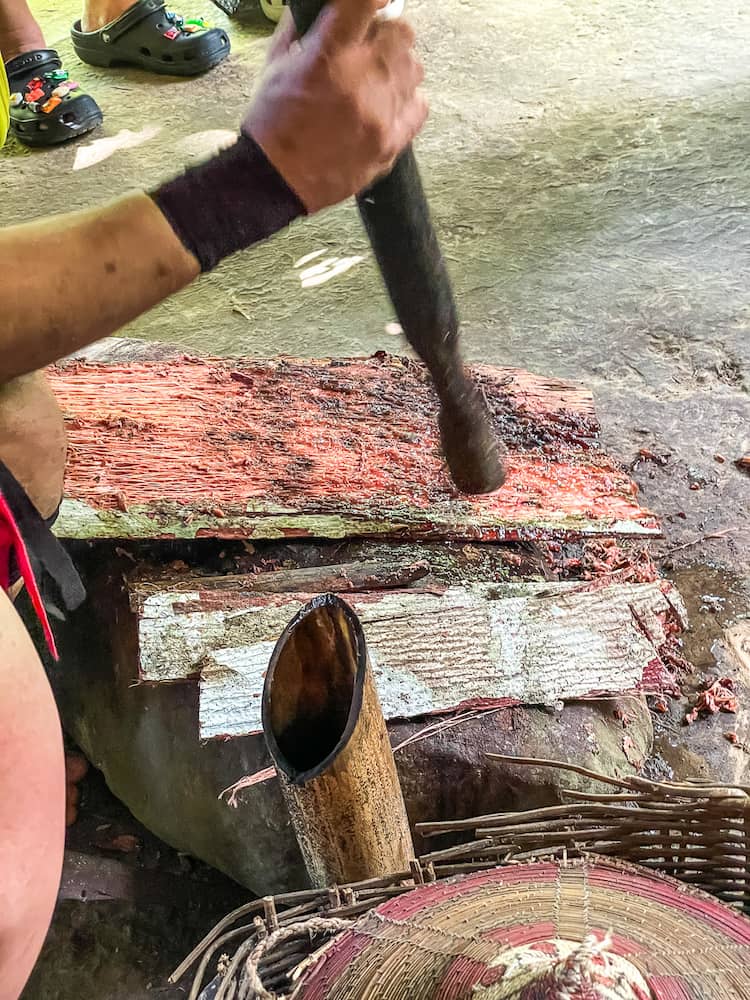
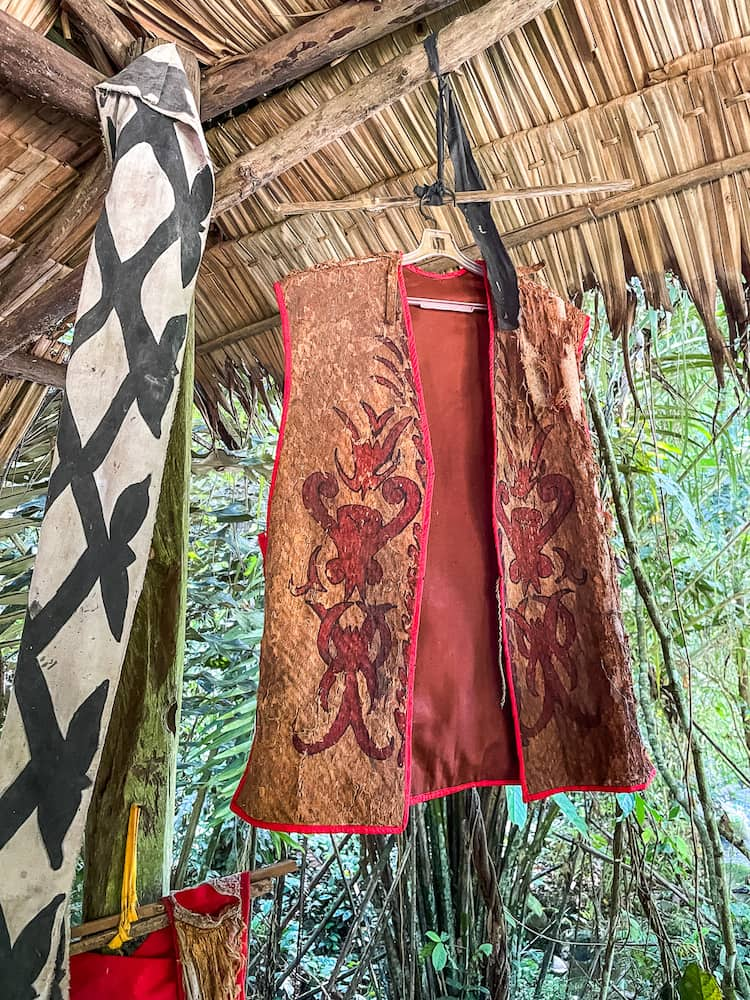
They believe that the power from the head of their victim will transfer to them. And they tattoo themselves each time they get a new head. In other incentives, men need to get at least one human skull in order to be eligible to get married. That skull makes a nice dowry!
For their own dead, they have an interesting burial tradition. They bury the bodies in jars in the jungle for four years. When just the skeleton is left, they put the bones in another jar and hang it on the tree. The higher the status of the individual, the higher up on the tree the jar goes.
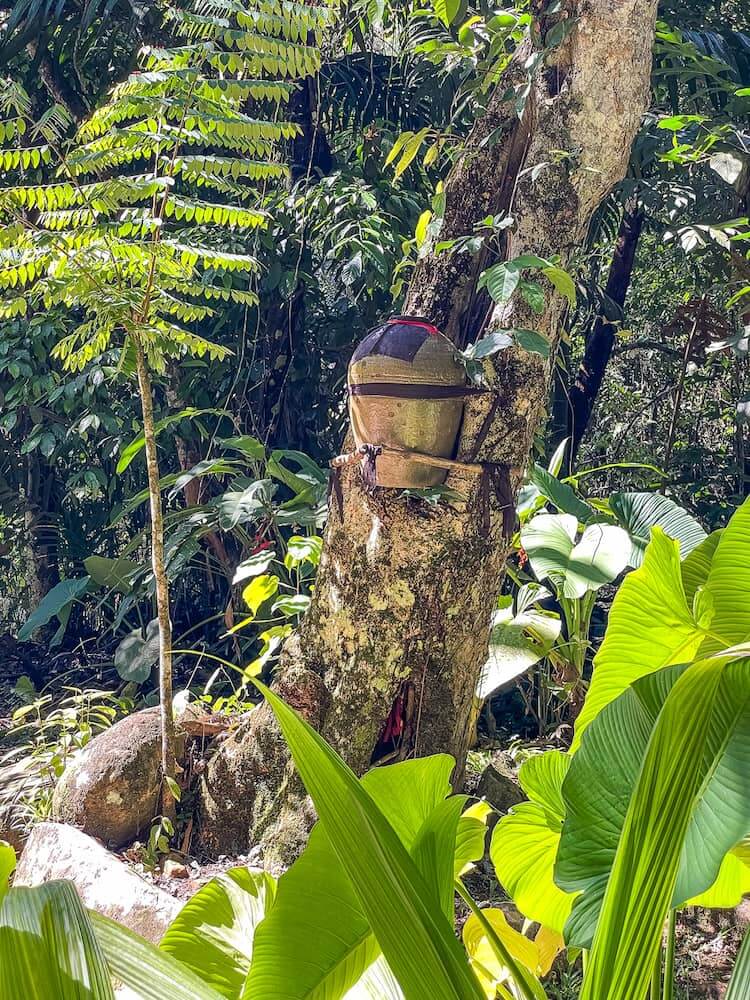
So if you see a jar in a Lundayeh village, make sure to check the color of the cloth cover. If it’s red, it’s rice wine. If it’s black, there’s a body in there.
Summary: At the Lundayeh house you will learn how tree bark clothing is made and see how to use a lethal blowpipe to inject Ipo tree poison into your enemy.
Cultural performance
After wandering through five hours, you will be ready to sit down and relax. All the groups come together at the big stage for a brief dance show.
The women dance. The men dance. The women and men dance together.
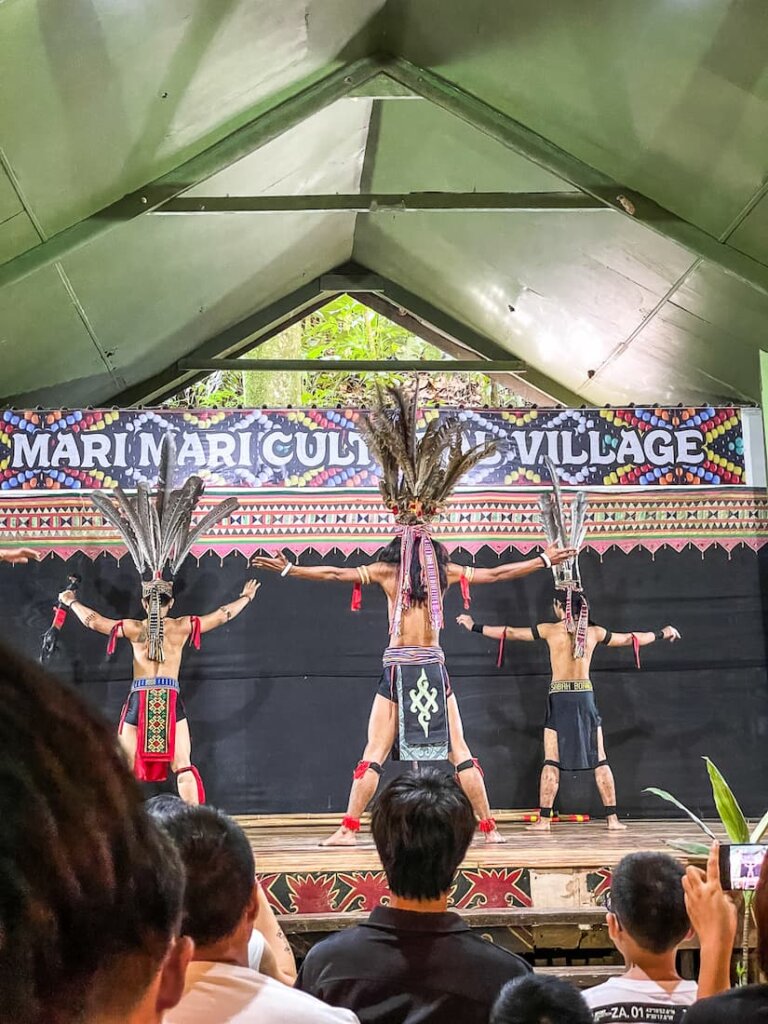
The bold ones in the audience also have a chance to dance. Also known as trying to not have your ankles smashed between bamboo bars! If you don’t want to risk that, you can just have your picture taken with the performers after the show.
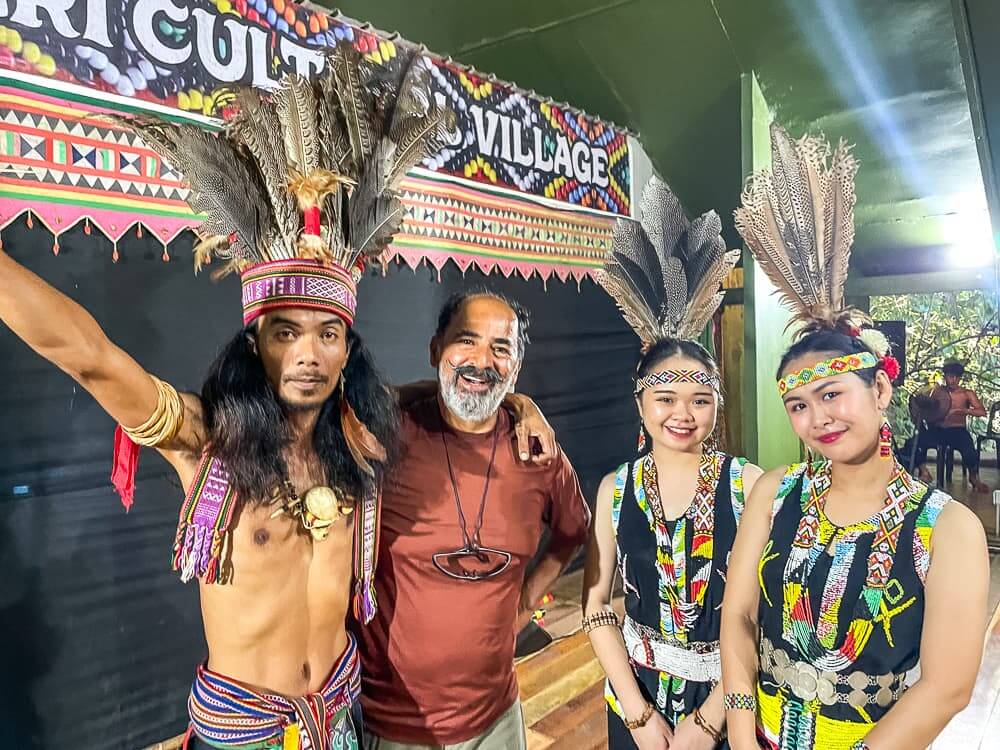
This is also your chance to get a henna tattoo (in case you didn’t have the opportunity at one of the houses).
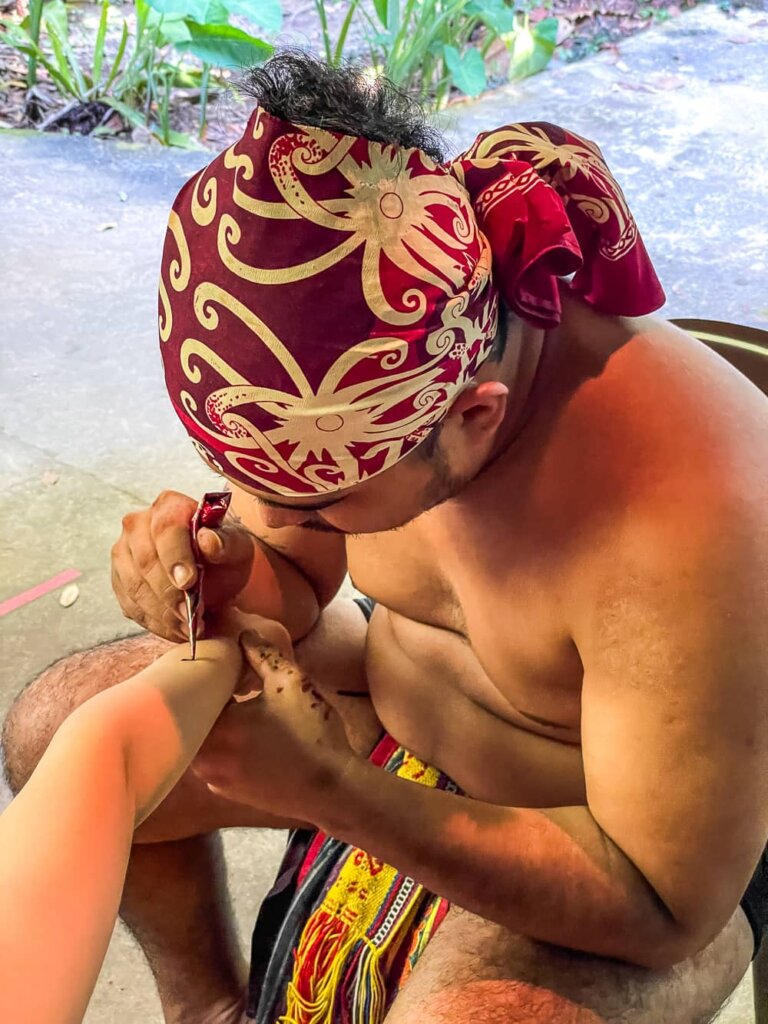
After the performance, it’s time to feast on traditional-ish food. Expect some sort of chicken, fish, rice, and fresh fruits (the menu varies). The meal was apparently not memorable enough for me to take a picture of it! But I do remember them running out of the good stuff early, so make sure to hop in line as soon as you can.
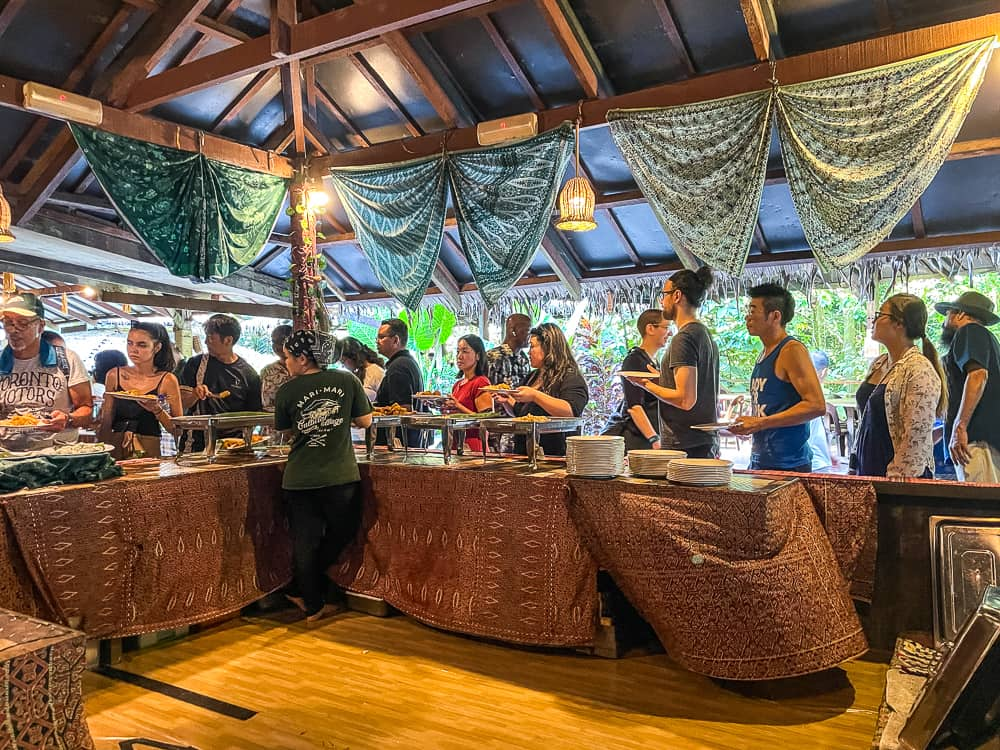
They offer water and tea, and there are other drinks available for purchase.
Where is Mari Mari Culture Village?
Mari Mari Culture Village is located about 20 km / 12 miles, or a 30-minute drive, from Kota Kinabalu. Just when you think you are getting into the jungle, you turn off and arrive at the village.
What are the hours at Mari Mari Culture Village?
You’re in luck! Mari Mari Culture Village is open every day, with guided sessions at 10am and 2pm. They ask you to arrive 15 minutes before the session.
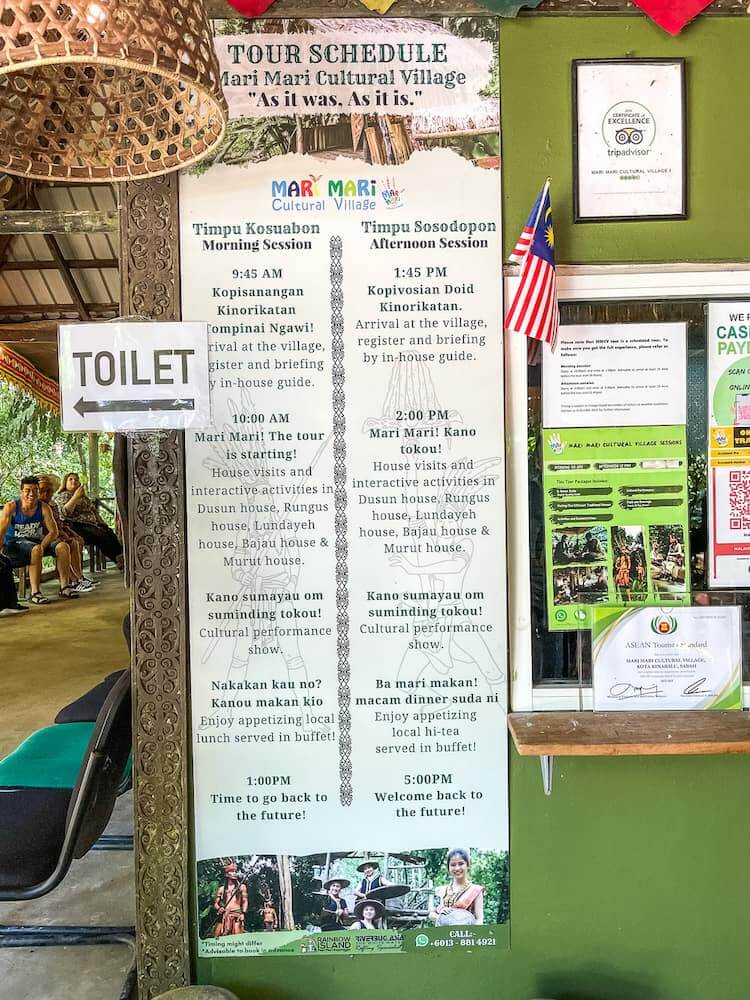
Expect to be at the Mari Mari Culture Village for 3 hours. The guided tour (the only option) takes about 2 hours, followed by the performance and meal, which together take about 1 hour.
How much does Mari Mari Culture Village Cost?
As of November 2024, a ticket to Mari Mari Culture Village costs RMB130 for non-Malaysian adults and RMB110 for non-Malaysian children. This comes to around $US30 per adult.
Book ahead if you can, as tours do sell out.
Your entrance fee includes a guide to take you through five traditional houses and explain the cooking demonstrations (with tastings) and cultural activities, a cultural performance, and a traditional meal (buffet style).
Additional drinks, snacks, and souvenirs are available for purchase.
You can also purchase tours to Mari Mari Culture Village that include transportation to and from KK. Tours with transportation will run you anywhere from US$60-120.
If you do book a tour, I would be skeptical of anything that offers a “private tour”. When we were there, they were very efficiently organizing people into groups of about 20 people to go from house to house. I didn’t see anything smaller that resembled a private tour.
How do you get to and from Mari Mari Culture Village?
Getting to and from Mari Mari Culture Village is the trickiest part of the whole thing. But you have a few options.
Taxi or Grab
It’s easy enough, and not too expensive to get a taxi or Grab to the Mari Mari Culture Village. My worry was how to get back. I mean, it’s quite a bit out of town and there aren’t many rides around. And you definitely don’t want to get stranded there!
Not to worry! When you arrive and check in at Mari Mari Culture Village, they will ask you if you need a taxi back, and if so, they will arrange it. Expect the cost to be similar (but maybe a little more) than what you paid to get there. In 2023, they quoted us MYR50 (around US$12), which seems quite reasonable.
Note that I did not try this option, but it sounded promising and convenient.
Private driver
We splurged a little and hired our driver from the previous day trip to Kinabalu National Park to take us to Mari Mari Culture Village, wait for us, and bring us back. We paid MYR180 (around US$40) for this peace of mind (in 2023).
Our trip that day also included a stop at the floating mosque in Kota Kinabalu on our way out.
Tour
The main benefit of any organized tour to Mari Mari Culture Village is the transportation. Everything else is going to be the same. If you are traveling solo, a tour is probably your most convenient and budget-friendly option, unless you are a hard-core budget traveler braving the public transportation option.
Public Transportation
There is no public transportation that will take you directly from Kota Kinabalu to Mari Mari Culture Village. That said, intrepid travelers with time and patience on their hands, have reportedly taken the public bus to Inanam and then arranged a quick taxi ride from there. Although I am not sure about how they got back…
Rental Car
If you are already renting a car on your trip, then it’s an easy drive.
Or if you find a really good deal on a car rental, it might make sense to rent a car just to get here, especially if you have a few people.
Just know that if you drive, the main parking lot fills up pretty fast, so get there early if you want a good spot.
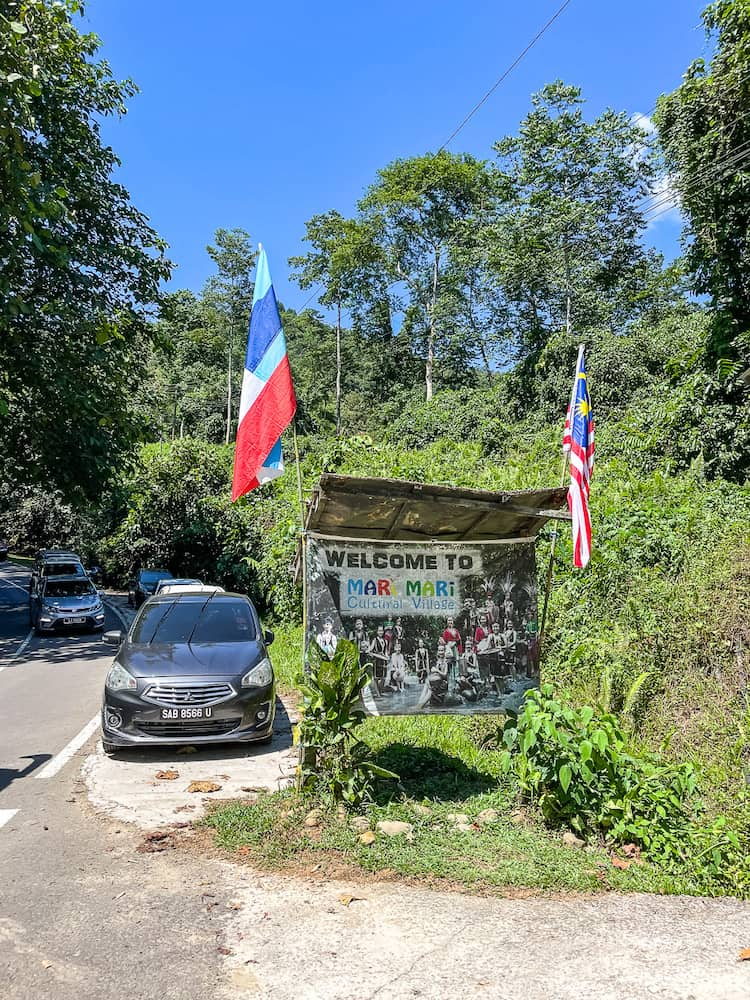
What should I bring to Mari Mari Culture Village?
It’s hot and sticky in this part of the world, pretty much all the time. You will be outside in the jungle environment, and inside the smoky homes. I’d suggest wearing a light long-sleeve shirt and loose pants or shorts.
You should bring bug spray and sunscreen (and a hat)—it’s hot and humid out there!
Definitely bring a bottle of water.
Can I bring my kids to Mari Mari Culture Village?
Full disclosure: I am not a parent and I don’t have kids. But I can tell you that there were quite a few children on our tour (of all ages) who seemed to be having fun. So your kids might enjoy it!
A few things to keep in mind:
- All the activities are outside, in typically hot and humid weather
- The tour is three hours long, including the performance and the meal
- There is some talking and demonstration at each house, but it’s fairly interactive and moves along
- There are some steep stairs, but the guide will help you or provide an alternate route
If your kids are old enough to appreciate these kinds of activities, and don’t mind these factors, I say go for it! And really, if you are the kind of family that takes your kids to Borneo, I think they’d be into it.
Final Thoughts
It doesn’t make sense to go to a place with a rich culture and history and not take time to learn a bit about it. Borneo, after all, has more than orangutans. It has been inhabited for tens of thousands of years by resourceful (and somewhat fearsome) humans.
Spending a morning or afternoon at Mari Mari Culture Village brings these people’s history to life. You will learn about how they lived, what they ate, and how they celebrated.

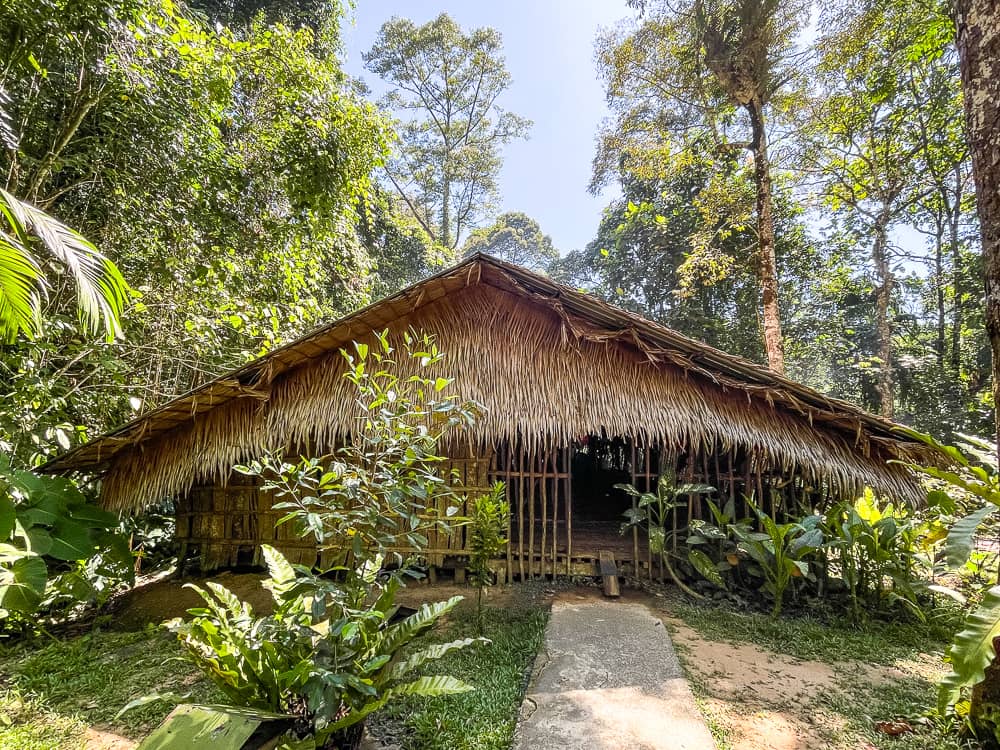
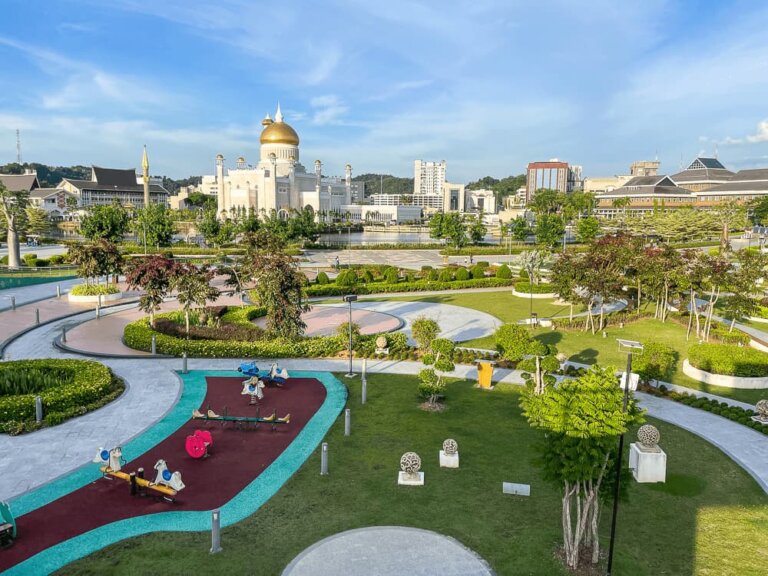
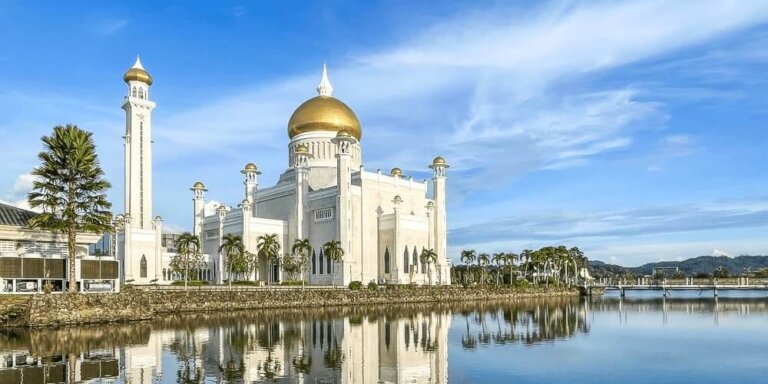
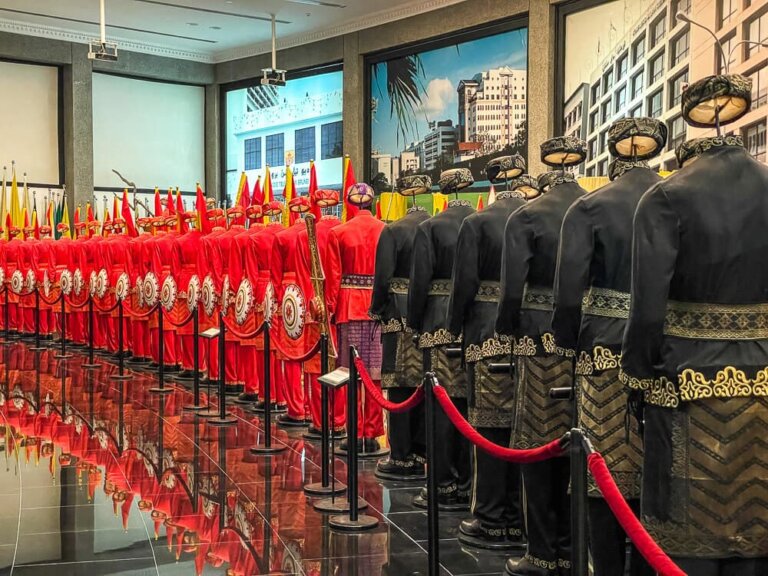
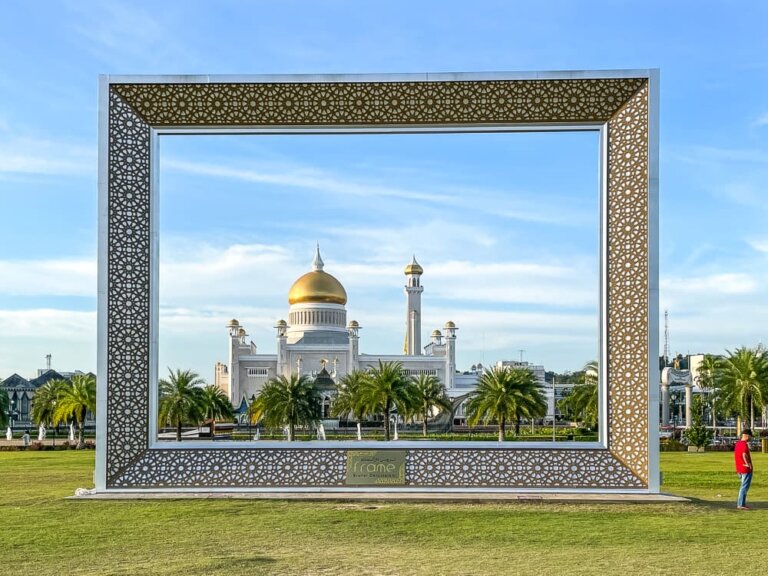
![A woman in a pink shirt points her left arm at a tall metal sculpture sign that says I [HEART] KK](https://bmorenomadic.com/wp-content/uploads/2024/11/BN-Borneo-KK-KingParkHotel-11-768x987.jpg)
